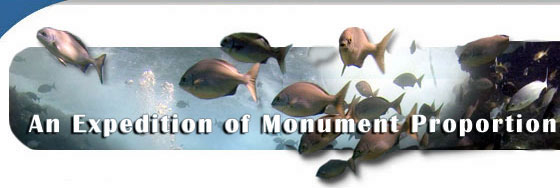|
Mission Log: July 1, 2006
Monk Seal KHOO
Ellyn Tong
Audubon Society
 |
| A large male Hawaiian monk seal swims by patrolling the beach while we were standing on the Green Island pier. (Photo: Claire Johnson/NOAA) |
I interviewed Buzzy Agard for Hawai`i Audubon Society about his experiences as a commercial fisherman in the Northwestern Hawaiian Islands (NWHI) and his feelings about how these islands should be managed. Buzzy fished the NWHI in the 1950s and 1960s. During this interview he told a story of how on one of his commercial fishing trips to the NWHI in the shallow nearshore reef area he found a large school of good-sized moi (six-fingered threadfin, Polydactyllus sexafillis). A delicious, esteemed fish, moi was once reserved for Ali`i and he was assured a very good price for this catch. He and his crew carefully surrounded the entire school with a seine net and sold the moi to an O`ahu market. He looked for several years for the same bounty, but the large school never returned. Realizing the fragility of the resources in the NWHI, Buzzy is now an advocate for the Kupuna Islands’ protection.
Some fishing interests have long pressured for continued or increased fishing in the NWHI.
 |
| A sandy beach of Green Island at Kure Atoll that monk seals enjoy lounging on. (Photo: Claire Johnson/NOAA) |
Though the kind of fishing Buzzy participated in happened many years ago, (before rules were made) and would not be allowed today, some fishing interests envision that changing. The future of a now-closed NWHI lobster fishery and the bottomfish fishery is now being decided. Although President Bush has declared the NWHI a Marine National Monument, and the state has declared state waters a no-take reserve, the Western Pacific Fishery Management Council is pressuring for fishing exemptions.
Hawaiian monk seals are a critically endangered species. Today the population is around
1400, but within ten years it is expected to drop to fewer than 1000. This decline is due adults naturally dying of old age and very few juveniles making it to adult age to take their place.
Hawaiian monk seals haul out and pup on Kure Atoll’s sandy beaches. A team of dedicated volunteers walks around Kure Atoll every four days to count the population and observe each year’s new crop of pups. Monk seal pups are fat and healthy until the time after they are weaned. Most seals die after leaving their mothers from starvation or predation.
Four years ago, a small school of good-sized moi could be found under the pier at Kure Atoll. A newly weaned pup KHOO developed an unusual talent of being able to prey on these fish. Moi are a delicious, high fat content fish and KHOO was observed with a moi tail playfully sticking out of his mouth. Soon the school was gone, but it sustained KHOO through his critical adolescent stage. Of all the pups born that year on Kure Atoll, he was the only survivor. Each monk seal pup is critical to the survival of the species. What would KHOO’s fate been, had there been not been a school of moi under the pier at Kure?
|



